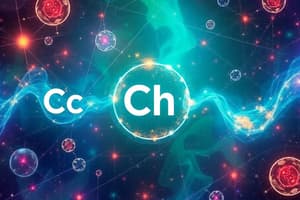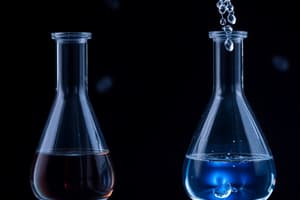Podcast
Questions and Answers
What is matter defined as?
What is matter defined as?
- Anything that can be observed with the naked eye
- Anything that takes up space and has mass (correct)
- Anything that can exist in solid, liquid, and gas forms
- Anything that has volume and weight
Which particle in an atom has a negative charge?
Which particle in an atom has a negative charge?
- Nucleus
- Neutron
- Proton
- Electron (correct)
What distinguishes isotopes of an element?
What distinguishes isotopes of an element?
- They have different numbers of protons
- They have different numbers of neutrons (correct)
- They have the same atomic mass
- They have identical properties in chemical reactions
Which property of water allows it to dissolve many substances?
Which property of water allows it to dissolve many substances?
What is the formation of covalent bonds primarily based on?
What is the formation of covalent bonds primarily based on?
Which of the following is an example of a polysaccharide?
Which of the following is an example of a polysaccharide?
In which type of reaction do water molecules break down larger molecules?
In which type of reaction do water molecules break down larger molecules?
Which element is known for its unique bonding properties, making it essential for life?
Which element is known for its unique bonding properties, making it essential for life?
What type of carbohydrate is formed by linking two monosaccharides together?
What type of carbohydrate is formed by linking two monosaccharides together?
Which of the following is an example of a polysaccharide?
Which of the following is an example of a polysaccharide?
Where is cellulose primarily found?
Where is cellulose primarily found?
Which carbohydrate serves as the primary energy storage form in animals?
Which carbohydrate serves as the primary energy storage form in animals?
Which of the following carbohydrates is not a simple sugar?
Which of the following carbohydrates is not a simple sugar?
What is the primary reason water is considered a universal solvent?
What is the primary reason water is considered a universal solvent?
Which type of bond is formed by the sharing of electrons between two non-metals?
Which type of bond is formed by the sharing of electrons between two non-metals?
What occurs during polar covalent bonding?
What occurs during polar covalent bonding?
Which of the following is NOT one of the properties of water that facilitates an environment for life?
Which of the following is NOT one of the properties of water that facilitates an environment for life?
Why is oil not soluble in water?
Why is oil not soluble in water?
What shape does a water molecule have due to its polarity?
What shape does a water molecule have due to its polarity?
Which type of bond is formed when a hydrogen atom is attracted to a highly electronegative atom?
Which type of bond is formed when a hydrogen atom is attracted to a highly electronegative atom?
What is the role of the solvent in a solution?
What is the role of the solvent in a solution?
What characterizes a compound compared to its constituent elements?
What characterizes a compound compared to its constituent elements?
What defines the atomic number of an element?
What defines the atomic number of an element?
Which statement about isotopes is accurate?
Which statement about isotopes is accurate?
What is a significant risk associated with the use of radioactive isotopes?
What is a significant risk associated with the use of radioactive isotopes?
Why are electrons often ignored when calculating the mass of an atom?
Why are electrons often ignored when calculating the mass of an atom?
What role do trace elements play in the human body?
What role do trace elements play in the human body?
Which components make up the atomic nucleus?
Which components make up the atomic nucleus?
How is atomic mass generally determined?
How is atomic mass generally determined?
What primarily causes the dissolution of sodium and chloride ions in water?
What primarily causes the dissolution of sodium and chloride ions in water?
Why does water have a higher boiling point compared to substances like ethanol?
Why does water have a higher boiling point compared to substances like ethanol?
What is responsible for water's high surface tension?
What is responsible for water's high surface tension?
What distinguishes specific heat capacity from heat capacity?
What distinguishes specific heat capacity from heat capacity?
In plants, what role does adhesion play?
In plants, what role does adhesion play?
What is the definition of cohesion in relation to water?
What is the definition of cohesion in relation to water?
What is a significant characteristic of water's specific heat capacity?
What is a significant characteristic of water's specific heat capacity?
Why is life considered carbon-based?
Why is life considered carbon-based?
Flashcards are hidden until you start studying
Study Notes
Matter and Elements
- Matter is anything that occupies space and has mass.
- Elements are substances that cannot be broken down into simpler substances.
- Compounds are formed when two or more elements combine in a fixed ratio.
- Trace elements are essential for various biological functions, such as iron for red blood cells and iodine for hormone regulation.
Atoms
- Atoms are the smallest unit of an element that retains its chemical properties.
- Atoms are made up of subatomic particles: protons, neutrons, and electrons.
- Protons carry a positive charge, neutrons have no charge, and electrons carry a negative charge.
- Protons and neutrons reside in the atomic nucleus, while electrons orbit the nucleus.
Atomic Number and Mass Number
- The atomic number of an element is the number of protons in its nucleus.
- The mass number of an element is the total number of protons and neutrons in its nucleus.
- Atomic mass is approximately equal to the mass number.
Isotopes
- Isotopes are atoms of the same element that have the same number of protons but different numbers of neutrons.
- Radioactive isotopes are unstable and decay over time, releasing energy as radiation.
Radioactive Isotopes
- Radioactive isotopes are used in medical diagnosis and treatment.
- They can be used to track metabolic processes, detect cancer cells, and deliver radiation therapy.
- Radiation can be harmful to healthy cells, causing side effects and potentially increasing cancer risk.
Chemical Bonds
- Chemical bonds form between atoms due to interactions between their electrons.
- Covalent bonds involve the sharing of electrons between two nonmetals:
- Polar covalent bonds: electrons are shared unequally.
- Nonpolar covalent bonds: electrons are shared equally.
- Ionic bonds form when electrons are transferred from a metal to a nonmetal.
- Hydrogen bonds are weak interactions between a hydrogen atom and a highly electronegative atom like oxygen or nitrogen.
Properties of Water
- Water is a polar molecule due to the uneven distribution of electrons in its covalent bonds.
- Water's polarity allows it to form hydrogen bonds with other water molecules and other polar substances.
- Water has several important properties that support life:
- High boiling point: due to strong hydrogen bonds.
- High heat capacity: water can absorb a lot of heat without significant temperature changes.
- Universal solvent: water's polarity allows it to dissolve many substances.
- High surface tension: water molecules at the surface are strongly attracted to each other.
- Cohesive and adhesive properties: water molecules stick to each other (cohesion) and to other polar surfaces (adhesion).
Biological Macromolecules
- Carbon is the basis of all organic compounds, including biological macromolecules.
- Carbohydrates serve as fuel and structural components for living organisms.
- Monosaccharides are simple sugars that act as monomers—building blocks for larger carbohydrates.
- Polysaccharides are polymers made up of many monosaccharide units:
- Starch: energy storage in plants.
- Glycogen: energy storage in animals.
- Cellulose: structural component of plant cell walls.
Studying That Suits You
Use AI to generate personalized quizzes and flashcards to suit your learning preferences.




